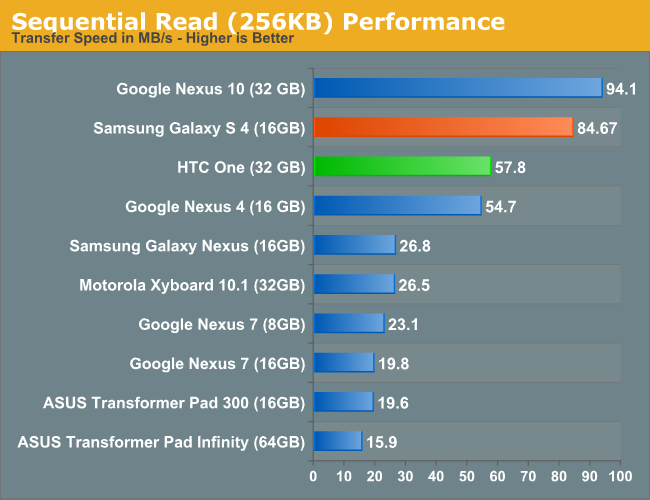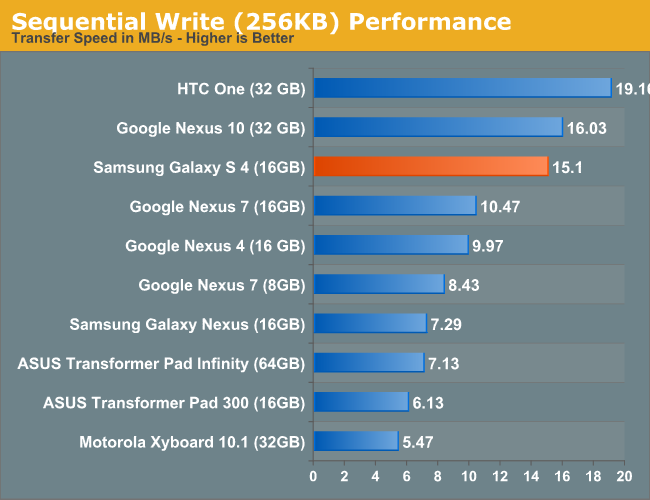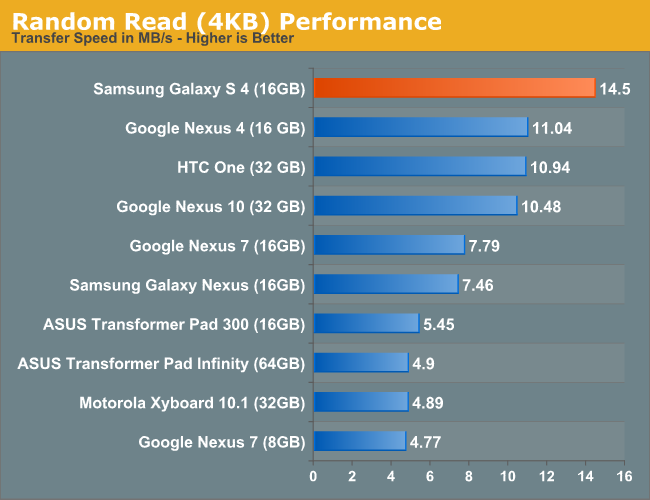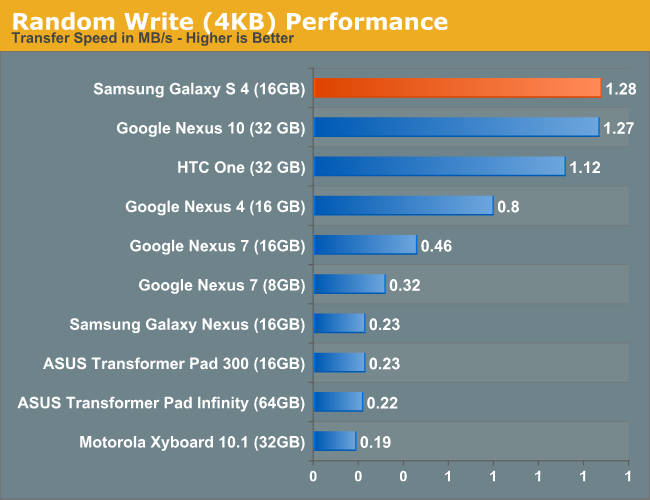Samsung Galaxy S 4 Review - Part 1
by Brian Klug on April 24, 2013 12:01 AM ESTNAND Performance
The Galaxy S 4 ships with either 16GB or 32GB of NAND on-board, but allows for expansion via a microSD card slot. The latter is a quickly disappearing feature on modern smartphones, but it remains a point of differentiation offered by Samsung. We were sampled a 16GB version of the Galaxy S 4, which arrived with 9.62GB of usable space after the OS and app pre-load.
As always we're using Androbench (with modified settings) to quantify NAND performance. Thankfully NAND performance has been steadily improving on modern smartphones/tablets, and the Galaxy S 4 is no exception. Sequential read performance actually sees a tremendous boost compared to most of the other devices in our charts here. Optimizing for sequential read performance makes a lot of sense, but it's good to see Samsung being competitive on all fronts here.
It is worth pointing out that NAND is treated very much as a commodity in these devices, and it's entirely possible that you'll see performance deviate from what we've shown here depending on what controller/NAND/firmware combination you get in your device.














335 Comments
View All Comments
blue_urban_sky - Wednesday, April 24, 2013 - link
I am very interested in the sock browser you mention."I find it difficult to hover my finger over the screen without touching it, but in the gallery and sock browser it is admittedly sometimes useful."
wenugopal - Wednesday, April 24, 2013 - link
Just curious, isn't galaxy s4 using LPDDR3 RAM, as opposed to LPDDR2 which is used in HTC One ? Hence, higher speeds ?Brian Klug - Wednesday, April 24, 2013 - link
Absolutely true, there's more to it than that though for things like CPU performance.-Brian
scaramoosh - Wednesday, April 24, 2013 - link
I have big doubts that DDR2 and 3 makes much difference, we never see much of a difference on the PC in day to day use, only benchmarks.B3an - Wednesday, April 24, 2013 - link
DDR3 is significantly faster than DDR2 on PC now. You can definitely notice a difference without benchmarks depending on what you're doing. Stupid comparison though because phones are too different.UpSpin - Wednesday, April 24, 2013 - link
because the RAM gets used for both CPU and GPU I think the upgrade to DDR3 makes a noticable difference, at least for the GPU. (the same way dual channel gives Intel IGP performance a boost compared to single channel)Mithos - Wednesday, April 24, 2013 - link
Man, I DO value removable battery as I'm the type that likes buying an extended battery for business trips. I rely on the GPS, constant mail checking and of course calls.But all that aside, I prefer the construction and UI the HTC One presents, yet it does not have expandable battery.
Ohhhh cruel world and it's first world problems.
Nice review, thank you for the hard work.
Gigaplex - Wednesday, April 24, 2013 - link
What's stopping you from getting a portable battery powered phone charger?Toss3 - Wednesday, April 24, 2013 - link
Removable battery does not just limit you to buying a separate one, but enables you to buy a 4500mAh after market battery that lasts two full days without charging. You cannot do that with the HTC One.UpSpin - Wednesday, April 24, 2013 - link
but this dramatically increases the size of the smartphone. I would rather buy a battery powered smartphone charger, which I can store in a bag or jacket and keep the already large smartphone comfortably sized. It's already thin, no question, but it's wide and long, and if it becomes thicker it becomes harder to use and to store it in a pocket.